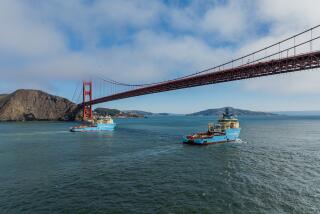White House Proposes $500-Million Oil Cleanup Fund
- Share via
WASHINGTON — Spurred by the outrage following the huge Alaska oil spill, the Bush Administration on Thursday proposed legislation creating a $500-million cleanup fund to be financed by an industry-paid fee on domestic and imported oil.
Outlining the plan in testimony before Congress, Transportation Secretary Samuel K. Skinner likened it to an “insurance fund” that would spread risk across the oil industry by levying a 1.3-cent fee on every barrel of oil over the next five years.
Noting the environmental tragedy that followed the March 24 spill of 11 million gallons by the Exxon Valdez in Alaska’s Prince William Sound, Skinner declared that it is “imperative to move quickly” to set up the federal fund as part of a comprehensive response to spills.
Skinner made his comments before the subcommittee on Coast Guard and navigation of the House Merchant Marine and Fisheries Committee, which already is considering similar legislation. Although such proposals have been pushed without success in Congress for the last 15 years, the hearing made it clear that the Alaska spill--the worst in U.S. history--has injected new vigor into the effort.
“Unfortunately, Valdez has given this legislation the kind of momentum it needs,” said Rep. W. J. (Billy) Tauzin (D-La.), chairman of the subcommittee.
Rep. Walter B. Jones (D-N.C.), committee chairman and sponsor of the bill that is similar to the Administration proposal, lamented that “it took a tragedy like the Exxon Valdez to cause the entire Congress to focus on the issue.” He added that “the time for delays is well behind us.”
Agreeing, Tauzin promised that the subcommittee will act on the bills, which are likely to be combined, on May 24. “We will not drag our feet,” he said.
Skinner, detailing the Administration bill, said that it would set a ceiling of $78 million on liability of tankers that spill, adding that operators of facilities such as outer continental shelf oil platforms would be liable for up to $75 million. In some cases, state laws would allow for more damages to be pursued. Skinner said the cost of cleaning up the spill at Prince William Sound is not known but that it could run even higher than $500 million.
The Exxon oil spill graphically illustrates the need for the fund, Skinner said, asserting that a company with fewer resources than Exxon would have been unable to pursue a cleanup. The existing federal oil spill contingency fund contained $4 million, he said.
The bill would establish a $10-million civil penalty to be assessed against spillers when natural resources are destroyed and cannot be replaced. This fine would be in addition to the spiller’s limited liability.
Skinner said that under the Administration bill, the $500-million pool could be increased with borrowed federal money “when the President determines that it is necessary to do so.” The fund would cover cleanup costs, restoration of damaged natural resources and damages to third parties, such as fishermen.
The Administration and some members of Congress strongly favor a provision in the legislation implementing two international protocols that provide for a worldwide system of liability and compensation similar to the bills in Congress. The protocols call for liability on spillers of as much as $78 million. Claims exceeding that figure could be paid from an international fund created under the protocols.
However, the two protocols have met opposition in the past because they would preempt state laws, thus setting lower limits on liabilities than some states allow.
Arguing for this provision, Brian Hoyle, director of the State Department’s Office of Ocean Law and Policy, told the subcommittee that the protocols would allow the United States to assume jurisdiction over foreign tankers in case of spills.
“Without jurisdiction, there is no way to compel foreign flag tanker owners to submit to our liability statutes or judicial process,” he testified.
Also testifying was Adm. Paul A. Yost Jr., Coast Guard commandant who is supervising Exxon’s cleanup. He offered a pessimistic view of the effort, saying that about 15% of the oil has been cleaned up and that about 25% has evaporated, “leaving a tarry and hard-to-handle substance, which is now on the beach.”
CHANGES AT EXXON--Exxon plans new policies after its oil spill. Business, Page 1
More to Read
Sign up for Essential California
The most important California stories and recommendations in your inbox every morning.
You may occasionally receive promotional content from the Los Angeles Times.













